A long, long time ago, Maryanne mentioned that no-one ever made her wearable items as gifts. Now, as a rule, I never make anyone wearable items as gifts (with the notable exception of the occasional wedding dress and stuff for my mother), but Maryanne is pretty special, and I thought it was high time someone did.
So, a long time ago (confession: this project was meant to be done for Flora & Fauna) I had a voucher for fabric from The Fabric Store, and they had just gotten some luscious silk velvets in, and I offered to make Maryanne a version of my 1930s Capelet in the silk velvet of her choice. She chose a glorious chocolate brown. Thich was quite fun for me, as I love chocolate brown but it really doesn’t love me. I offered to supply the lining as well, but she already had a beautiful silk dupion embroidered with Poiret roses in her stash that she wanted me to use, and no wonder: it’s AMAZING.
So I started making the capelet, but because the velvet and the dupion were both quite wide, I got ambitious and decided to see if I could make up my capelet pattern in one piece, with no centre back seam.
The short answer is: not without a lot of difficulty, as the asymmetrical grain lines go all wonky on the very unstable silk velvet, and are a nightmare to work with.
So there was a great deal of unpicking and re-sewing and muttering dire threats at the silk velvet, and finally I had to resort to entirely hand-sewing the capelet to get it to work, and the long and the short of it is that it wasn’t done for Flora & Fauna.
Instead it sat in a bag for a few months, but last week I fished it out and painstakingly basted and hand sewed and matched grainlines and finished it. And it’s done now! And it’s worth it!
And did I mention that it is totally reversible?
And Hurrah! Maryanne likes it too! Mission accomplished!
She looks much better in it than Isabelle, because she has the shoulders to carry it off.
The Challenge: #20: Outerwear
Fabric: 1/2 metre silk velvet, 1/2 metre embroidered silk dupion.
Pattern: My own, taken from an original vintage piece
Year: ca. 1938
Notions: Thread
How historically accurate is it? The pattern is taken from an extent piece, but I’ve modified it to be a shorter cape. However there are examples of later 30s short capes. The silk velvet is a period accurate fabric, and the colour is period appropriate. The silk dupion lining is the only slightly out of period factor. 80%
Hours to complete: After 6 months, I’m not sure anymore.
First worn: Today! She immediately put it on and dashed out to her evenings entertainment!
Total cost: Lots and lots of love
Since the resident cat’s feelings about this item are irrelevant as it isn’t going to live in her house, I’ll leave you with this photo of Maryanne being ridiculous in her new cape. It seemed to bring out the sill in her!


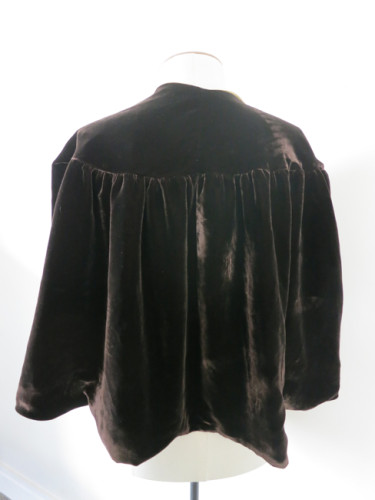
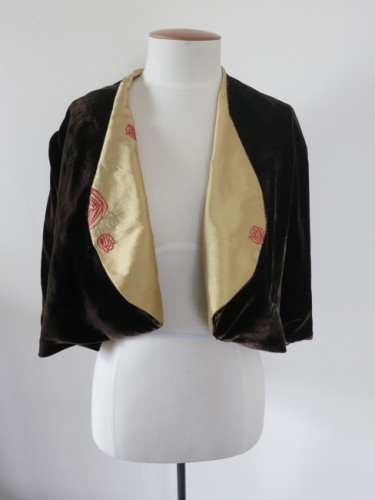
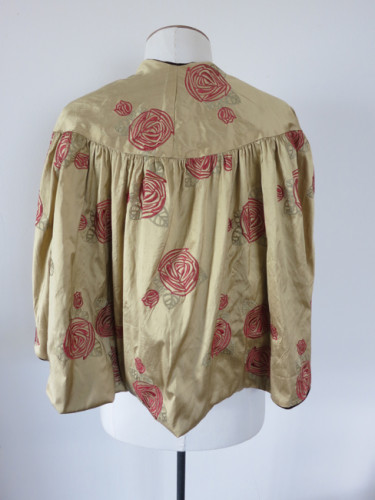
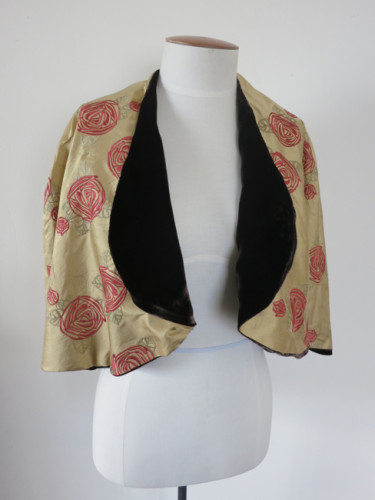
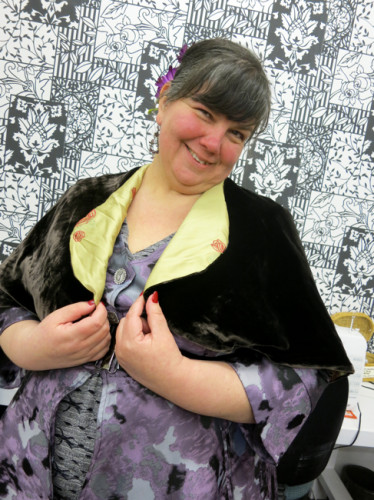

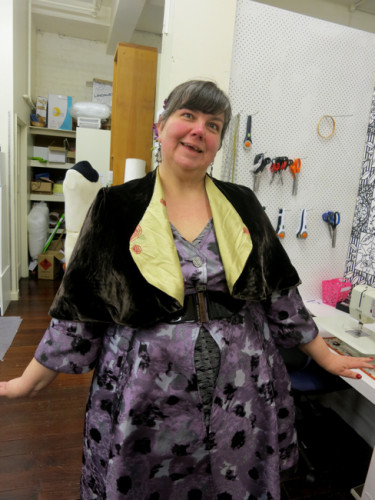
It’s lovely, and I think reversible garments are neat. I’ve made two in my history as a costumer; a medieval hood, and a so-called “bog coat” (really only historically inspired, in my opinion, but it makes a lovely garment all the same).
By the way, since you only used 1 metre of fabric all told, this project fits within the “one metre challenge which is coming up (doesn’t it?). So it isn’t late, it’s early!
And reversibility would be a great challenge for next year’s HSF: “Both Sides Now”–make a garment that’s completely reversible, i.e., can be worn with either side on the outside of the garment.
Would there be many options for that? I can barely think of any historical garments that are completely reversible.
The 1930s capelet is, of course, such a garment. 🙂
For earlier periods, it may be hard to document completely reversible garments, but that does not mean they cannot be or were not made (or could not be made for this challenge.) It’s not that hard, for example, to make a medieval hood that is completely reversible.
In any event, it’s an idea to discuss.
Why do I remember reading that aprons were often reversible: one side for work with the ability to turn it over to the ‘clean’ side for company?
Elise; I’ve read that too, though I’m not sure whether the idea came from someone’s research or from a costumer’s or reenactor’s speculation.
Any garment that is basically a flat sheet of fabric can easily be reversible, say, a shawl, or a semicircular cloak; that certainly includes aprons. Simple items can also be made reversible, such as pouches (though I botched the last one I tried, the technique is not especially complicated).
In any event (as Leimomi’s posts show), not all HSF challenges need to result in a product that is all, or even primarily, historically documentable.
I loves it! Can you tell from the look on my face hehhe. It’s ironic that I chose yesterday to wear purple so it clashes with this outfit but goes with just about everything else in my wardrboe. You know I had forgotten about moaning about never getting made things, what a great listener you are.
I feel like a queen in this cape and VERY glamorous too, thnk you SOOO much! oxoxoxo
How utterly luxurious and beautiful! It’s stunning, but with all that hand sewing I can imagine why you’d put it off, especially if your eyes were giving you grief. The lining is perfect – and having it fully reversible makes it even better!
It’s glorious. Any chance of some sort of line drawing of the pattern so I can have a go at drafting one? I’ve got some lovely blue silk velvet here that’s been in the stash for over a decade now.
I think it was worth all the extra muttering – what a lovely thing!
I suppose I’m late to post this (it’s been a crazy week) but I really wanted to thank you for hosting the HSF again next year. When I found your blog a few weeks ago, I was really disappointed that such a fun, doable-looking project was almost over, since something like this would really help me get moving. I’ve been very slowly self teaching myself this sort of thing for a long time now due to resource and time constraints, and it’s-not-good-enough procrastination. I think the HSF will really make a difference in the latter two, especially if I can join from the start, so thank you so much for hosting it again for those of us who didn’t have a chance the first time. Maybe I’ll even manage to do the Outerwear challenge, if I can find a worthy fabric of sufficient yardage for a boring-but-much-coveted cloak.
And since I’ve already committed myself to commenting (I’ve been too irrationally shy about it for the last few weeks), I wanted to let you know how much I enjoy this blog. I’m not often one for really sticking to them, but I find the amount of research, your writing style, and your choice of topics/approach very appealing. Sometimes it’s difficult to write something fairly obscure or in-depth without boring those who know about it or confusing those who don’t, but I’ve found your posts are consistently interesting whether I know a lot or zip about your topic. I’ve learned a lot from your progress posts too. You also have a knack for showing and discussing really useful parts of your work–which is gorgeous, by the way.
(By the way, I second the reversible garments challenge! It’s like a companion to “Separates.”)
[WORDPRESS HASHCASH] The poster sent us ‘0 which is not a hashcash value.
I have a serious case of chocolate silk velvet envy.
And what a totally fabulous cape. The lining is scrumptious (and I ought to thank you for that word, by the way), and the silk velvet is – well, you see above. And the hard work definitely did pay off, because now there’s no seam to disturb that lovely, lovely velvet.
Yay! Beauty!
Beautimous!
Since answering Elise’s post, I’ve been thinking about historical garments that could plausibly and easily be made reversible. Although I don’t know offhand of references documenting the existence of historical garments that *were* reversible, it would be easy to make a number of types of historical garments reversible (and to do so in a way that would make it very difficult to tell, while they were being worn, that the garment was a reversible garment).
I started to do this in my answer to Elise, but there’s more types of garment that could fit in this category than I’d originally thought. Here are the types I’ve come up with so far:
Flat or slightly shaped outer garments: capes and capelets (such as the 1930’s capelet that is the subject of the current post); cloaks, esp. semicircular and rectangular ones, shawls (esp. knitted or crocheted ones).
Flat accessories: aprons (as Elise said), pockets, pouches, hats, fichus, kerchiefs, scarves.
Flat items worn on the torso: Corsets (Leimomi did a lovely one c. 1890s) and corselettes; belts, and lace-up bodices (though this I truly doubt would have been done in period).
Shaped items with no pockets and few openings: Hoods, mitts, skirts (probably unlikely in period due to bulk, but at least theoretically possible), overskirts (more likely, because their purpose was usually ornamental anyway and fabric choice could be used to keep bulk to a minimum).
That’s what I could think of so far….
Well, my 18th century shifts are all effectively reversible, because they are so nicely finished on the inside that I can turn them wrong side out and wear them no problem. Still, I think it’s a challenge that a lot of people would struggle with, and find very confining.
That’s your call to make. But I’ve enjoyed discussing the idea anyway.
Me too–thank you for your insight, Catherine.
Ohhhh. Cool reply.
I still think it would be an interesting challenge whether a person does something historical-or just to take pleasure in seeing how people finish their historical products on the inside.
Gorgeous!
Well, now, another one of my favorites of things you have made. It suits Maryanne perfectly, and my, it’s so sophisticatedly glamorous. Wonderful work!!
Very best,
Natalie
Call it “Inside Out” – then that gives people scope to decide whether they want to make something reversible, something with a very special lining or interior finish, or even some period underwear.
I have been playing with ideas for using it – I was thinking Interiors, so either insides out, focus on interior finishes, or even things specifically to be work inside (bed jackets etc). But there are a lot of ideas for next year!
This is so lovely!